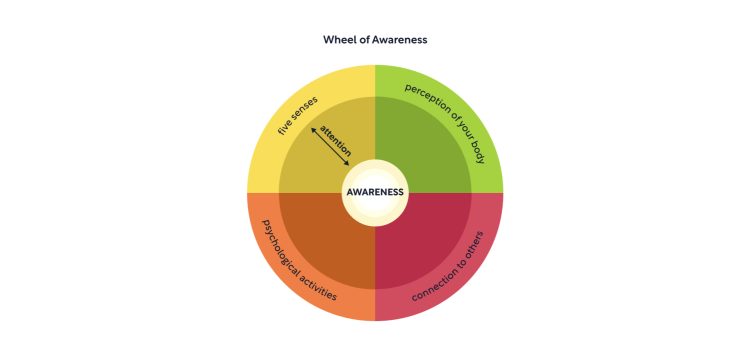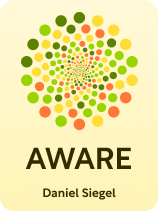

This article is an excerpt from the Shortform book guide to "Aware" by Daniel Siegel. Shortform has the world's best summaries and analyses of books you should be reading.
Like this article? Sign up for a free trial here.
How can you expand your awareness? What ancient practices inspired the Wheel of Awareness meditation?
According to Dan Siegel, the Wheel of Awareness can be a powerful tool for meditation. The wheel guides you through different exercises to increase your consciousness and improve your ability to live in the present moment.
Keep reading to explore this meditation technique.
Dan Siegel on the Wheel of Awareness
According to Dan Siegel, the Wheel of Awareness can expand your mind’s capacity for awareness and improve your ability to live in the present moment. This meditation tool uses the image of a wheel and its various parts to guide you through different exercises to increase your consciousness of awareness.
Picture a simple wheel: The hub represents your awareness in the center of the wheel. The wheel’s outer rim represents all the things you can focus your attention on, like thoughts, feelings, sensations, and perceptions. Your awareness in the center hub is connected to the outer rim by a spoke, which represents your attention. As your attention shifts to different aspects of your world, the spoke moves around the circle.
The rim of this wheel is divided into four parts.
- The first section represents everything you can be aware of through your five senses—sounds, sights, smells, tastes, and touch sensations.
- The second section represents your perceptions of your body, such as how your muscles feel or the sensations in your gut.
- The third section represents psychological activities such as thoughts, feelings, and memories.
- The fourth section represents your experiences of connection to and relationships with others.
| The Ancient Origins of the Wheel Mediation The Wheel meditation combines elements from various mediation practices that people have been practicing for thousands of years, including Buddhist and Hindu contemplative and spiritual practices. The hub, representing pure awareness, is similar to the Hindu concept of Sakshi, which means pure consciousness. And Buddhist Vipassana meditation helps you cultivate awareness of your own awareness, which is often called “the witness.” The first, second, and third quarters of the rim correspond to mindfulness of the senses and body in Buddhist Satipatthana practice, the four foundations of mindfulness, which include the systematic observation of bodily sensations, feelings, and mental activities. The fourth quarter is similar to the Buddhist practice of Metta—loving-kindness, in which you cultivate goodwill and compassion toward yourself and others. |
How to Practice the Wheel Meditation
To meditate with the Wheel, Siegel recommends you take a few moments to do the breath meditation you’ve been practicing. Then move your spoke of attention through the four Wheel sections. The full meditation takes around 30 minutes.
Section #1: Your Five Senses
First, with your eyes closed, picture the Wheel of Awareness as described above and imagine yourself in the center, the hub of awareness. Next, imagine sending your attention out from the hub like a spoke to the first section of the rim: your five senses. Begin to focus on the sensations you can perceive with each sense. Start with the sensations of hearing and move to sight, smells, taste, and touch (sensations coming in through your skin, like how your clothes feel or the temperature). Focus on each sense for at least 15 to 30 seconds.
Section #2: Your Body Sensations
Next, take a deep breath and move your spoke of attention to the second section of the rim: the internal sensations of your body. As you move through this section, focus your awareness on each part of your body for at least five to 15 seconds. Begin with your face, then move your awareness to your forehead, scalp, down the sides of your head, to your ears and neck. Then, move on to your shoulders and down both arms to your hands and fingers. Come back to your upper back and chest and down to your lower back and abdomen. Then, go to your hips, down both legs, feet, and toes.
Next, come back up and focus your attention on the sensations in your pelvic area, including your genitals, then up to your intestines and your stomach. Then, move up through your chest and esophagus to the inside of your mouth, the sinuses behind your cheekbones, the inside of your nose, and then back down your throat into your lungs. Feel both of your lungs expand and contract. Then, move your attention to your heart. And lastly, expand your attention and try to become aware of the inside of your entire body at once.
Section #3: Your Mind
Now, take a deep breath and move your spoke to the third section of the wheel: the mental processes of your thoughts, memories, emotions, daydreams, and so on. In this section, don’t focus your attention on sensations. Instead, open your awareness to notice whatever comes up in your mind. Try to stay with this section for at least a minute and a half.
Recall that Siegel says there’s nothing that’s supposed to come to mind during this section—allow whatever happens in your mind to happen and just notice it. Try to notice how something like a thought or feeling first appears in your awareness—does it pop in suddenly or come on slowly? Once it’s there, does it stick around for a while or leave quickly? Does your mental space feel chaotic or clear? Can you sense a gap between each thought, memory, or emotion? Or do they rush in one right after the other?
Then, practice becoming aware of your own awareness. To do this, imagine bending the spoke of your attention back toward the center of the wheel so that you can practice being aware of your awareness itself. Try to become aware of your own awareness for at least one minute. Siegel writes that when first practicing the Wheel meditation, you can skip this part of the process. Instead, when doing this section, focus only on your mental thoughts as described above. Once you’ve gained mastery of the meditation, you can add in this step of becoming aware of your awareness.
Section #4: Interconnection & Kind Intentions
Again, take a deep breath and imagine moving the Spoke to the fourth section of the rim: your sense of connection to others. Begin by letting yourself become aware of your connection to the people and animals physically closest to you. Then, expand that sense of connection to the friends, family, and animals not physically close to you. Next, move your awareness to the people and animals you spend time with at work, school, and community. Then, expand your relational connection to all the beings in your neighborhood, your town or city, region or state, and then to all the beings living in your country and continent. Lastly, try to reach your sense of connection out to encompass the planet.
Finally, extend kind intentions—loving and kind well-wishes—to all the living beings in your life, especially to other people.
- Start by saying these simple expressions aloud or silently to yourself: “May all living beings be happy. May all living beings be healthy. May all living beings be safe. May all living beings flourish and thrive.”
- Next, move on to the following statements, which add more detail to the expressions: “May I be happy and live with meaning, connection, and equanimity, and a playful, grateful, joyful heart. May I be healthy and have a body that gives energy and flexibility, strength and stability. May I be safe and protected from all sorts of inner and outer harm. May I flourish, thrive, and live with ease and well-being.”
- Lastly, repeat the detailed phrases from the previous step but replace the “I” with “We” to cultivate a sense of interconnection and interrelation with the beings in your life and on the planet. For example, you’ll say, “May we be happy and live with meaning…” etc.
Siegel writes that this step, of extending kind intentions, is another step you can skip when you begin to meditate with the Wheel. Instead, you can focus only on the first aspects of this section—becoming aware of your connection to others. Then, when you’ve gained some mastery of the meditation, you can add this step in.
After completing the meditation session, take a few mindful breaths and then slowly open your eyes.
Exercise
The Wheel of Awareness meditation puts you in touch with foundational facets of life: awareness, thoughts, feelings, bodily sensations, and relationships. The following exercise will guide you through applying the Wheel meditation practices to your daily life.
- Reflect on a recent experience where you felt caught up in the “rim of the wheel,” such as feeling strong emotions or having racing thoughts. What were the sensations, images, feelings, and thoughts associated with this situation?
- How might your experience have been different in that moment if you had been able to shift your attention to the “hub” of awareness instead of to your sensations and thoughts?

———End of Preview———
Like what you just read? Read the rest of the world's best book summary and analysis of Daniel Siegel's "Aware" at Shortform.
Here's what you'll find in our full Aware summary:
- The benefits of increasing your awareness of yourself and the world
- How to use a meditation tool called the Wheel of Awareness
- How the Wheel of Awareness improves your bodily functions






